| The Ballad of Oriana | |
|---|---|
| by Alfred Tennyson | |
| Publication date |
|
| Lines | 55 (66) |
| Full text | |
"The Ballad of Oriana" is an early poem by Alfred Tennyson, published in 1830, but not in 1833. [1]
| The Ballad of Oriana | |
|---|---|
| by Alfred Tennyson | |
| Publication date |
|
| Lines | 55 (66) |
| Full text | |
"The Ballad of Oriana" is an early poem by Alfred Tennyson, published in 1830, but not in 1833. [1]
According to critic John Churton Collins, "This fine ballad was evidently suggested by the old ballad of "Helen of Kirkconnel", both poems being based on a similar incident, and both being the passionate soliloquy of the bereaved lover, though Tennyson's treatment of the subject is his own." [1]
"Helen of Kirkconnel" was one of the poems which he was fond of reciting, and Fitzgerald says that he used also to recite this poem, in a way not to be forgotten, at Cambridge tables. [1] [2]
My heart is wasted with my woe, Oriana.
There is no rest for me below, Oriana.
When the long dun wolds are ribb’d with snow,
And loud the Norland whirlwinds blow, Oriana,
Alone I wander to and fro, Oriana.Ere the light on dark was growing, Oriana,
At midnight the cock was crowing, Oriana:
Winds were blowing, waters flowing,
We heard the steeds to battle going, Oriana;
Aloud the hollow bugle blowing, Oriana.In the yew-wood black as night, Oriana,
Ere I rode into the fight, Oriana,
While blissful tears blinded my sight
By star-shine and by moonlight, Oriana,
I to thee my troth did plight, Oriana.She stood upon the castle wall, Oriana:
She watch’d my crest among them all, Oriana:
She saw me fight, she heard me call,
When forth there stept a foeman tall, Oriana,
Atween me and the castle wall, Oriana.The bitter arrow went aside, Oriana:
The false, false arrow went aside, Oriana:
The damned arrow glanced aside,
And pierced thy heart, my love, my bride, Oriana!
Thy heart, my life, my love, my bride, Oriana!Oh! narrow, narrow was the space, Oriana.
Loud, loud rung out the bugle’s brays, Oriana.
Oh! deathful stabs were dealt apace,
The battle deepen’d in its place, Oriana;
But I was down upon my face, Oriana.They should have stabb’d me where I lay, Oriana!
How could I rise and come away, Oriana?
How could I look upon the day?
They should have stabb’d me where I lay, Oriana
They should have trod me into clay, Oriana.O breaking heart that will not break, Oriana!
O pale, pale face so sweet and meek, Oriana!
Thou smilest, but thou dost not speak,
And then the tears run down my cheek, Oriana:
What wantest thou? whom dost thou seek, Oriana?I cry aloud: none hear my cries, Oriana.
Thou comest atween me and the skies, Oriana.
I feel the tears of blood arise
Up from my heart unto my eyes, Oriana.
Within my heart my arrow lies, Oriana.O cursed hand! O cursed blow! Oriana!
O happy thou that liest low, Oriana!
All night the silence seems to flow
Beside me in my utter woe, Oriana.
A weary, weary way I go, Oriana.When Norland winds pipe down the sea, Oriana,
I walk, I dare not think of thee, Oriana.
Thou liest beneath the greenwood tree,
I dare not die and come to thee, Oriana.
I hear the roaring of the sea, Oriana.
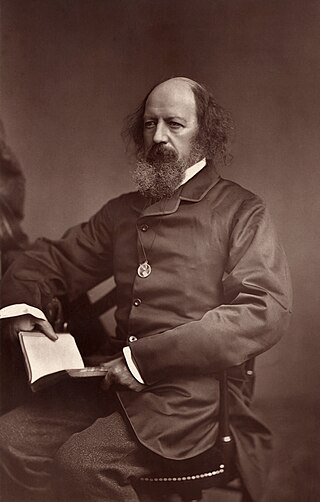
Alfred Tennyson, 1st Baron Tennyson was an English poet. He was the Poet Laureate during much of Queen Victoria's reign. In 1829, Tennyson was awarded the Chancellor's Gold Medal at Cambridge for one of his first pieces, "Timbuktu". He published his first solo collection of poems, Poems, Chiefly Lyrical, in 1830. "Claribel" and "Mariana", which remain some of Tennyson's most celebrated poems, were included in this volume. Although described by some critics as overly sentimental, his verse soon proved popular and brought Tennyson to the attention of well-known writers of the day, including Samuel Taylor Coleridge. Tennyson's early poetry, with its medievalism and powerful visual imagery, was a major influence on the Pre-Raphaelite Brotherhood.
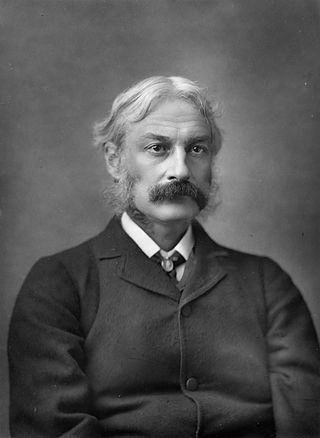
Andrew Lang was a Scottish poet, novelist, literary critic, and contributor to the field of anthropology. He is best known as a collector of folk and fairy tales. The Andrew Lang lectures at the University of St Andrews are named after him.
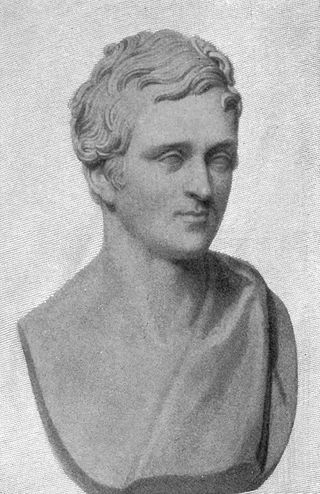
Arthur Henry Hallam was an English poet, best known as the subject of a major work, In Memoriam, by his close friend and fellow poet Alfred Tennyson. Hallam has been described as the jeune homme fatal of his generation.

"Ulysses" is a poem in blank verse by the Victorian poet Alfred, Lord Tennyson (1809–1892), written in 1833 and published in 1842 in his well-received second volume of poetry. An oft-quoted poem, it is a popular example of the dramatic monologue. Facing old age, mythical hero Ulysses describes his discontent and restlessness upon returning to his kingdom, Ithaca, after his far-ranging travels. Despite his reunion with his wife Penelope and his son Telemachus, Ulysses yearns to explore again.

John Churton Collins was a British literary critic.
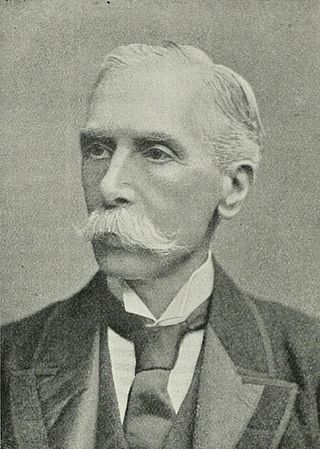
Alfred Austin was an English poet who was appointed Poet Laureate in 1896, after an interval following the death of Tennyson, when the other candidates had either caused controversy or refused the honour. It was claimed that he was being rewarded for his support for the Conservative leader Lord Salisbury in the General Election of 1895. Austin's poems are little remembered today, his most popular work being prose idylls celebrating nature. Wilfred Scawen Blunt wrote of him, “He is an acute and ready reasoner, and is well read in theology and science. It is strange his poetry should be such poor stuff, and stranger still that he should imagine it immortal.”

"The Charge of the Light Brigade" is an 1854 narrative poem by Alfred, Lord Tennyson about the Charge of the Light Brigade at the Battle of Balaclava during the Crimean War. He wrote the original version on 2 December 1854, and it was published on 9 December 1854 in The Examiner. He was the Poet Laureate of the United Kingdom at the time. The poem was subsequently revised and expanded for inclusion in Maud and Other Poems (1855).

Maud, and Other Poems (1855) was Alfred Tennyson's first published collection after becoming poet laureate in 1850.
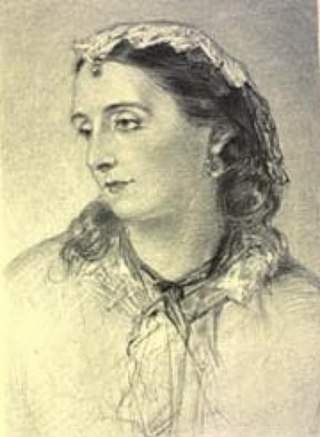
Helen Selina Blackwood, Baroness Dufferin and Claneboye, later Countess of Gifford, was an Irish songwriter, composer, poet, and author. Admired for her wit and literary talents, she was a well-known figure in London society of the mid-19th century.

Edmund Henry Garrett (1853–1929) was an American illustrator, bookplate-maker, and author—as well as a highly respected painter—renowned for his illustrations of the legends of King Arthur.

"Mariana" is a poem by Alfred, Lord Tennyson, published in 1830. The poem follows a common theme in much of Tennyson's work—that of despondent isolation. The subject of "Mariana" is a woman who continuously laments her lack of connection with society. The isolation defines her existence, and her longing for a connection leaves her wishing for death at the end of every stanza. The premise of "Mariana" originates in William Shakespeare's Measure for Measure, but the poem ends before Mariana's lover returns. Tennyson's version was adapted by others, including John Everett Millais and Elizabeth Gaskell, for use in their own works. The poem was well received by critics, and it is described by critics as an example of Tennyson's skill at poetry.
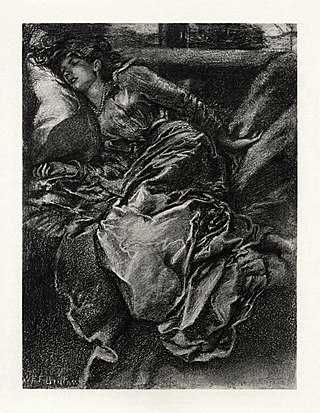
"The Day-Dream" is a poem written by Alfred Tennyson that was published in 1842. It was an expanded version of his 1830 poem "The Sleeping Beauty". It was further altered in 1848 for a dramatic performance for a private gathering with Tennyson starring as the Prince. "The Day-Dream" discusses the nature of sleeping and of dreaming, especially in relation to individuals that would want to escape from reality. The poem also compares the act of poetry with dreaming and asserts that the two are the same.
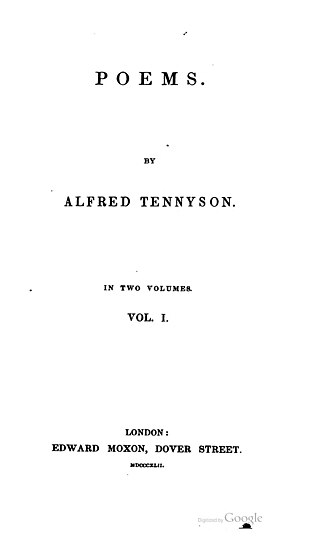
Poems, by Alfred Tennyson, was a two-volume 1842 collection in which new poems and reworked older ones were printed in separate volumes. It includes some of Tennyson's finest and best-loved poems, such as Mariana, The Lady of Shalott, The Palace of Art, The Lotos Eaters, Ulysses, Locksley Hall, The Two Voices, Sir Galahad, and Break, Break, Break. It helped to establish his reputation as one of the greatest poets of his time.
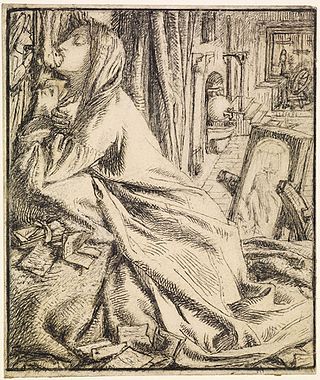
"Mariana in the South" is an early poem by Alfred Tennyson, first printed in 1833 and significantly revised in 1842.

The Miller's Daughter is a narrative poem by Alfred Tennyson, first printed in 1833 and significantly revised in 1842.

"St. Agnes" is a poem by Alfred Tennyson, first published in 1837, revised in 1842, and retitled "St. Agnes' Eve" in 1857.

Lady Clare is a narrative poem by Alfred Tennyson, first published in 1842.
Poems, Chiefly Lyrical is a poetry collection by Alfred Tennyson, published in June 1830.
"Claribel: A Melody" is an early poem by Alfred Tennyson, first published in 1830.
"Recollections of the Arabian Nights" is an early poem by Alfred Tennyson, first published in 1830.